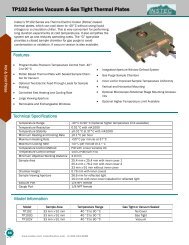Liquid Crystal Measurement Instruments 2007 - Instec Inc
Liquid Crystal Measurement Instruments 2007 - Instec Inc
Liquid Crystal Measurement Instruments 2007 - Instec Inc
You also want an ePaper? Increase the reach of your titles
YUMPU automatically turns print PDFs into web optimized ePapers that Google loves.
IV1 - LC Tester for Ion, Resistivity, VHR, and RDC<br />
<strong>Instec</strong> designed the IV1 specifically with the industrial customers in<br />
mind. Its electronics are capable of exceedingly sensitive current<br />
measurement and low leakage voltage measurement. Its cables and<br />
connectors are triaxial in order to allow guarding against external leakages.<br />
The IV1 can be configured to measure any or all of the following:<br />
• Ion Density<br />
• <strong>Liquid</strong> <strong>Crystal</strong> Resistivity<br />
• Voltage Holding Ratio (VHR)<br />
• Residual DC (RDC)<br />
Ion density and liquid crystal resistivity are critical components in the proper functioning of any LC display but especially<br />
active matrix LCDs. With too many contaminant ions or too low a resistivity, displays are prone to problems such<br />
as image retention and flicker. These measurements are useful to LC manufactures both in the development of liquid<br />
crystals and quality control. In addition, display manufacturers can use them for both incoming and in line quality inspection<br />
and as a diagnostic tool to trace down root causes of problems on the line.<br />
VHR and RDC are a more direct probe for potential problems. Lowered Voltage Holding Ratios can result in noticeable<br />
flicker to a display user. Elevated Residual DC values can also produce flicker and/or image retention (or image<br />
sticking).<br />
In measuring VHR, the IV1’s built in function generator outputs to the sample under test an AC pulse train of user<br />
adjustable frequency, amplitude, and duration. Simultaneously, the IV1’s internal electrometer senses changes in voltage<br />
on the sample, in particular the voltage droop between pulses. For the measurement of RDC, the IV1 applies a set<br />
DC voltage to the liquid crystal cell of user selectable magnitude and duration. The built in electrometer then records<br />
the residual DC voltage left on the sample cell, again for a user selectable duration. Since the duration of the initial DC<br />
voltage may be an hour or more, while the measurement time may be set to ten or more minutes, a single RDC determination<br />
can be a long process. With that in mind we designed the IV1’s electronics with a modular structure and options<br />
exist to add up to 8 channels.<br />
Technical Specifications<br />
Ion/Resistivity<br />
Voltage (Min)<br />
Voltage (Max)<br />
Resolution<br />
Frequency<br />
Current Range<br />
Current Resolution<br />
Electrical Connections<br />
Voltage (Min)<br />
Voltage (Max)<br />
Resolution<br />
Output Current<br />
Offset Voltage<br />
Input Capacitance (Hold Mode)<br />
Leak Current (Hold Mode)<br />
V.G Offset (Hold Mode)<br />
Charge Injection<br />
Electrical Connections<br />
± 10mV<br />
± 10V (± 100V optional)<br />
100 μ V<br />
0.01 ~ 1kHz<br />
100pA to 1mA<br />
1pA<br />
Triaxial<br />
Voltage Holding Ratio / Residual DC Voltage <strong>Measurement</strong><br />
± 10mV<br />
± 10V<br />
100 μ V<br />
± 100mA (Max)<br />
± 0.1mV<br />
< 1pF<br />
< ± 0.1pA<br />
± 0.1mV<br />
± 5pC<br />
Triaxial<br />
7



